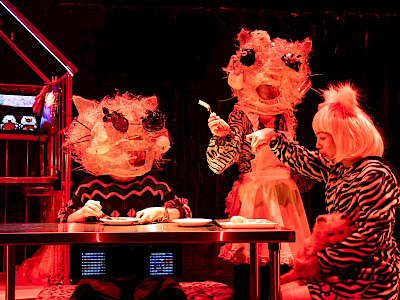17 — 19.05.2025
Satoko Ichihara Tokyo
KITTY
theatre
| Japanese, Korean, Cantonese → FR, NL, EN | ⧖ ±1h50 | €20 / €16 | Contains acts of sexual violence, rape and references to alcohol abuse
Playwright and director Satoko Ichihara is known for her fearless yet subtle probing of taboos and sexual contradictions in Japanese society today. In her new creation, KITTY, she zooms in on a society populated by white cats, a parallel universe frighteningly similar to ours.
Here, Ichihara creates a sharp and humorous analogy between the treatment of animals and the objectification of women. Her work grew out of research on sex trafficking from various perspectives, the position of women in current society, and the consumption of meat. The performance asks incisive questions about the comically absurd distortions that arise from mass production and consumption, patriarchy, capitalism, and the global homogenisation of desire. Livestock whose reproduction is controlled to become food. Sexual contexts entrap people without them realising it. Appalling work conditions in the pursuit of profit above all else. The word 'kawaii' (cute) appears again and again, but its meaning changes each time.
A cast of actresses from Japan, South Korea, and Hong Kong brings to life a play brimming with energy and satire that will send shock waves through audiences. This radical redefinition of life and sexuality is a must-see.
Interview with Satoko Ichihara
Yannaï Plettener – What was your inspiration for this show? Notably, you travelled to Korea and met sex workers.
Satoko Ichihara – I wanted to meet the author after reading the book Prostitution, a Black Hole of Common Sense by Korean abolitionist and activist Shin-Park Jin-young. For her, sex workers are victims first and foremost, whereas I had read other books that defended their rights on the same basis as other workers.
In Seoul, in the Yeongdeungpo district where prostitution is concentrated, I passed a booth dedicated to sexual relations. Glancing inside, I noticed a curtain featuring a famous white cat mascot that’s marketed worldwide. Its black eyes met mine. This character exists only as a product, a symbol of consumer society. In a world where everything is marketable, it seemed natural to me that sex would also become a product. This mascot was the inspiration for KITTY.
Why did you choose to create the piece with three actresses from different countries (Japan, South Korea, Hong Kong)?
I had become friends with two of the actresses on another project in 2018. We realised that, despite our physical resemblance and our belonging to the same generation and
sharing cultural references, we had different opinions on sex work and pornography. What’s more, one of the unique features of this cat mascot is that it has no mouth. So when you own a product on which she is featured, you can make her speak in your own language and project your own emotions onto her. For all these reasons, I thought it would be interesting to stage KITTY with three female actors from different backgrounds who embody the same character. Like the mascot, the character of the young woman on stage is
empty and acquires meaning through the voices that are superimposed onto her.
How is artificial intelligence (AI) used to separate the voice and body of the performers?
We provided AI with a sample of each actress’s voice. AI then produced recordings of the text in the three languages, using the three voices, which were finally remixed by our
sound designer, Masamitsu Araki, to create what you hear in the show. For the movements, we used motion capture technology based on an initial physical performance by the players. We shifted the positions of the sensors on the computer in relation to reality: for example, the head sensor was placed on the shoulder, and so on. This produced a movement that was completely disjointed, which the performers then repeat in the show, like a choreographed dance. By combining the synthetic voice and the reworked movement, I wanted to create a state in which the actors are completely empty, like a commercial mascot. This approach is also in line with my previous creation, Yoroboshi, in which the performers manipulated puppets.
In the show, the main character repeatedly says that it is “impossible to escape pornography”. What do you mean by that?
The Japanese pornography market is one of the largest in the world. It offers a wide variety of productions, and it is fair to say that almost every scene from everyday life has
already been adapted into a pornographic film. Generally speaking, there is nothing in this society that is not related to sex or consumption. This statement refers to a dual phenomenon: everything is designed to constantly stimulate our desires, whether sexual or consumerist. There is nowhere to escape.
The play establishes a link between our relationship with sexuality and our relationship with animals and meat consumption. What prompted this connection?
During my research in Korea, I saw sex workers waiting for clients in windows lit by red lights. The same lights were used to illuminate raw meat in butcher’s shops. These are two places where flesh is sold, human or animal. Similarly, in language, we use food-related vocabulary to talk about sexuality, for example with the verb ‘to eat’ referring to certain acts, or the expression ‘carnal pleasure’.
With these white-cat characters inspired by this mascot, you are working on the concept of kawaii. What does this word mean to you?
In everyday language the word kawaii evokes something cute, and by extension childish and weak. But for me, it evokes something strong and determined, linked to the notion of survival. Certain animals retain their juvenile characteristics, particularly for protection, in a phenomenon known as neoteny. This is also why children have ‘cute’ physical features that make us want to take care of them. It’s a survival strategy. The white cat mascot is not a weak character: it is precisely its kawaii appearance that has placed it at the top of the pyramid by making it adorable. And perhaps girls who own products bearing its image feel that they share with it this strength.
What are host clubs, and why did you want to talk about this phenomenon?
I couldn’t talk about prostitution without mentioning host clubs. In Tokyo’s Kabuki-chō district, there are numerous host bars where men entertain women. In recent years, countless women, some of them minors, have ended up prostituting themselves to pay for the extravagant costs of these clubs, or sex workers have fallen into debt by frequenting them. They are seeking the love of these boys. And in this city, everything can be bought, except unconditional love.
- Interview by Yannaï Plettener for the Festival d’Automne in Paris in April 2025.
- Translated by Jodie Hruby.
Yannaï Plettener is an actor and director and writer of the magazine Pleins Feux.
Presentation: Kunstenfestivaldesarts, Théâtre Les Tanneurs
Written and directed by: Satoko Ichihara | Cast: Sung Soo-yeon (Creative VaQi), Yurie Nagayama (Seinendan), Birdy Wong Ching Yan (Artocrite Theater), Yuka Hanamoto (Yuka Hanamoto × Moe Matsuki) | Music: Masamitsu Araki | Costumes: Shie Minamino (Osushi) | Scenography: Tomomi Nakamura | Lighting: Rie Uomori (kehaiworks) | Video: Kotaro Konishi | Dramaturgy: Takaaki Kumakura | Stage management: Yuhi Kobayashi | Production management: Rika Kihara, Mizuki Kakita, Shunsuke Manabe | Promotional design: Eiko Sasaki | English surtitles: Aya Ogawa
Production: ROHM Theatre Kyoto
With the support of ROHM Theatre Kyoto (Kyoto City Music Art Cultural Promoting Foundation), Kyoto City | In cooperation with Kinosaki International Art Center (Toyooka City)
With the assistance of the Saison Foundation





